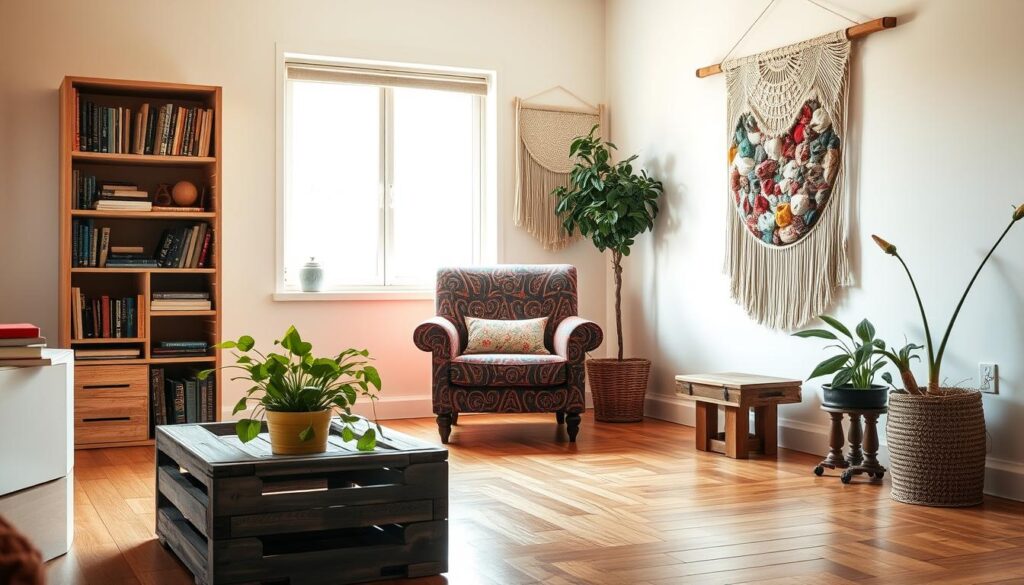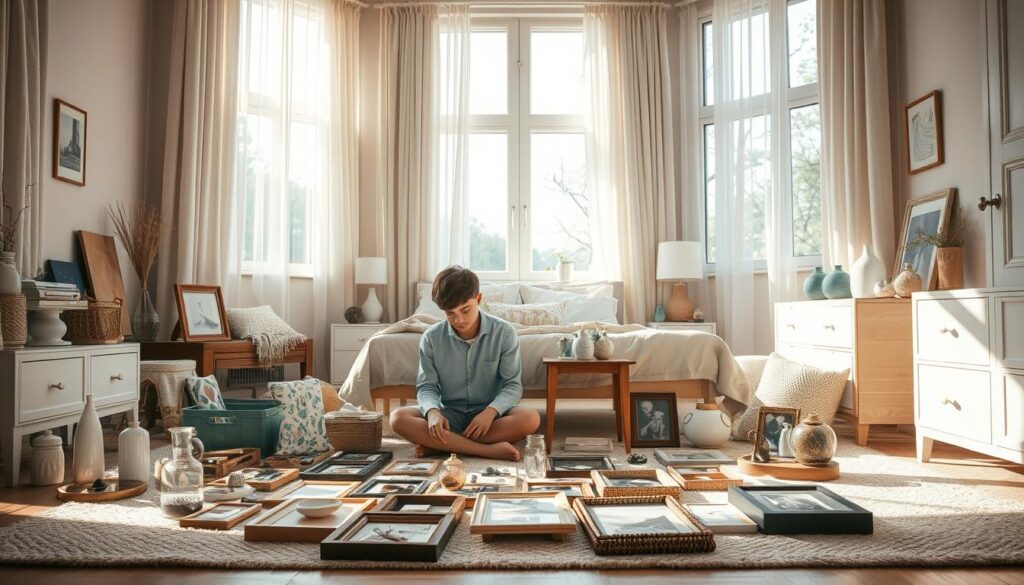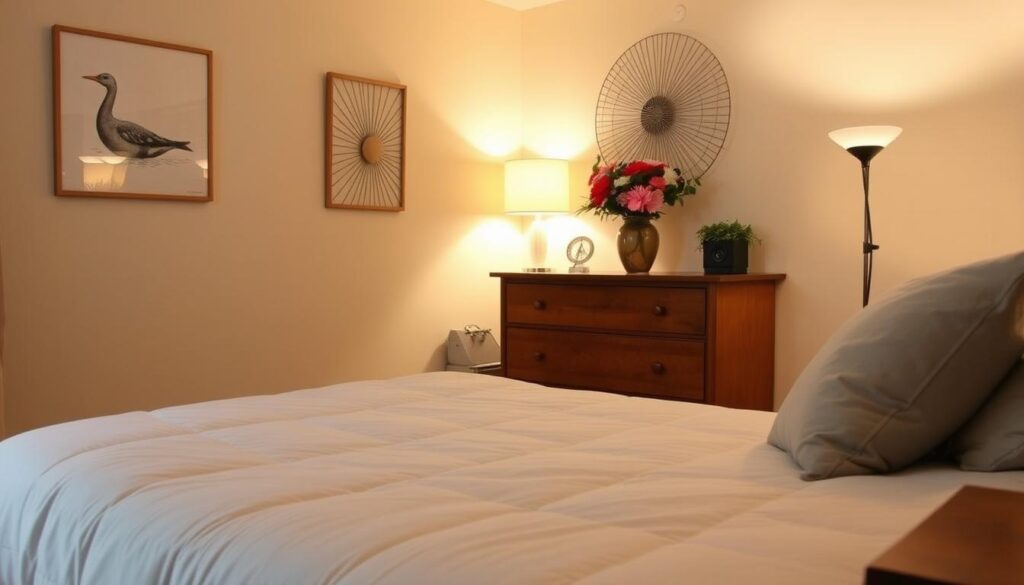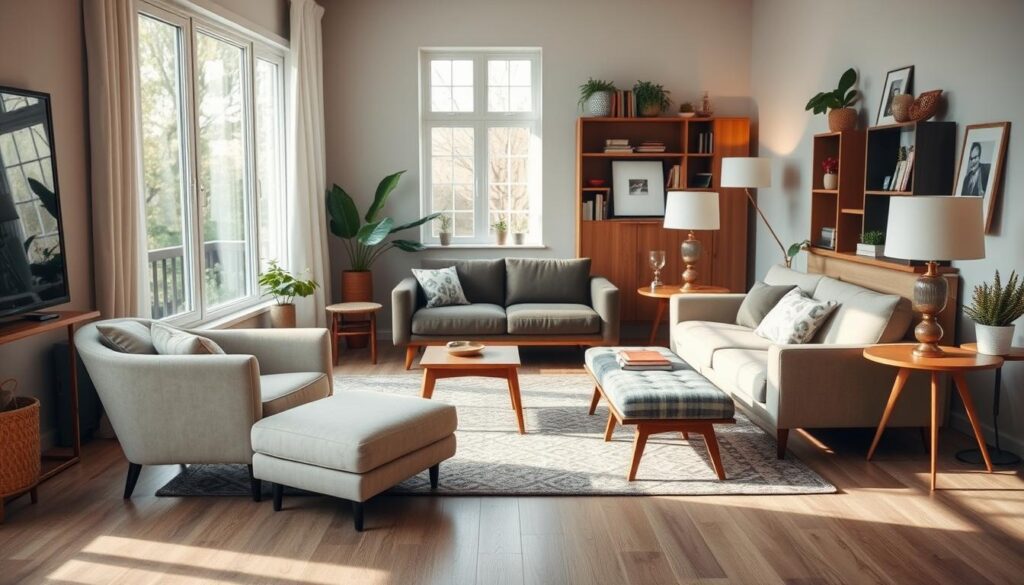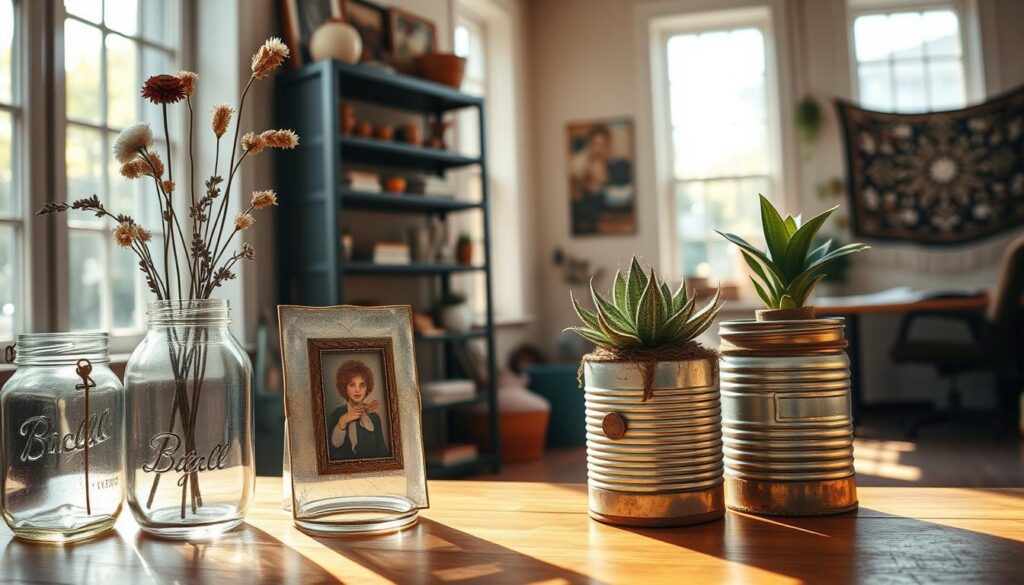Are you tired of living in a space that doesn’t reflect your personality? Can you really make a difference in your room’s decor without breaking the bank? The answer is a resounding yes! With a little creativity, you can transform your room into a cozy and inviting space using items you already have.
Decorating on a budget doesn’t mean you have to compromise on style. By repurposing and reusing existing items, you can create a unique and personalized space that showcases your taste. In this article, we’ll explore five practical ways to give your room a makeover without spending a dime.
Key Takeaways
- Discover creative ways to reuse items you already own
- Learn how to repurpose old furniture into new decor
- Get inspired to create a unique and personalized space
- Find out how to make a big impact with small changes
- Explore budget-friendly decor ideas that don’t compromise on style
The Art of Zero-Cost Room Transformation
Revamping your room without purchasing anything new is a sustainable and cost-effective approach. This method not only helps you save money but also encourages creativity and reduces waste.
Why Free Decoration Makes Sense
Decorating without buying anything new makes sense for several reasons. It allows you to be creative with the resources you already have, reducing the need for new purchases.
Financial Benefits in Today’s Economy
In today’s economy, saving money is more important than ever. By choosing to decorate without spending, you’re making a financially savvy decision. This approach can help you allocate resources to other important areas of your life.
Developing Creativity and Problem-Solving Skills
Engaging in DIY decor projects without purchasing new items fosters creativity and enhances problem-solving skills. You’ll be surprised at how a fresh perspective can transform your space.
Environmental Benefits of Using What You Have
Using what you already have is not only budget-friendly but also environmentally conscious. It reduces the demand for new products, thereby decreasing waste and consumption.
Reducing Waste and Consumption
By repurposing items you already own, you’re contributing to a reduction in waste. This eco-friendly approach helps minimize the environmental impact of consumerism.
Creating a Sustainable Living Space
A sustainable living space is achieved by making the most of what you already have. This not only benefits the environment but also creates a unique and personalized living area.
Before You Start: Assessing Your Space
Assessing your space is the first step towards a successful no-cost room makeover. This involves taking a thorough inventory of the items you already own and identifying areas in your room that need improvement.
Taking Inventory of What You Already Own
Begin by making a list of all the items you have in your room, including furniture, decor, and other objects. Look for hidden treasures in storage that could be repurposed or rearranged to enhance your space.
Hidden Treasures in Storage
Check your closets, drawers, and storage bins for items that could be used differently. You might find old jars that can be used as vases or fabric scraps that can be turned into wall art.
Forgotten Items with Decorative Potential
Consider items that are no longer used for their original purpose but could serve as decorative pieces. For example, an old ladder can become a bookshelf, or a vintage window can be used as a room divider.
Identifying Problem Areas in Your Room
Walk through your room and identify areas that feel cluttered or uninviting. Look for dead spaces that can be optimized and address any visual clutter that’s detracting from the overall aesthetic.
Recognizing Dead Spaces
Dead spaces are areas that are not being utilized effectively. These could be corners, the space under your bed, or areas around your furniture. Think about how you can use these spaces to enhance your room’s functionality and look. For more ideas on stylish home decor on a budget, check out our guide on stylish home decor on a budget.
Addressing Visual Clutter
Visual clutter can make a room feel chaotic and overwhelming. Sort through your belongings and remove or rearrange items that are contributing to this clutter. By doing so, you’ll create a more peaceful and inviting atmosphere.
Preparation Steps for a No-Cost Room Makeover
A successful room transformation without buying anything starts with thorough preparation. This involves decluttering your space and creating a clear vision for your room’s new look.
Decluttering Your Space
Decluttering is a crucial step in preparing your room for a makeover. It helps you understand what you have to work with.
The 15-Minute Decluttering Method
Start by setting a timer for 15 minutes and quickly sorting items into categories: keep, donate, and discard. This method helps you stay focused and makes the task less overwhelming.
Organizing by Function and Aesthetic
Once decluttered, organize your remaining items by their function and how they contribute to the room’s aesthetic. This step is crucial for a cohesive look.
Creating a Vision for Your Room
After decluttering, it’s time to envision your room’s new layout and design.
Finding Inspiration in What You Already Have
Look around your home for items that can be repurposed or rearranged to fit your new room design. This approach fosters creativity and resourcefulness.
Setting Realistic Transformation Goals
Be realistic about what you can achieve with the items you have. Setting achievable goals ensures a successful transformation.
Way #1: Rearranging Furniture for a Fresh Perspective
One of the simplest and most effective ways to decorate your room without buying anything is by rearranging the furniture you already have. This approach not only saves money but also gives you the opportunity to explore your creativity. Rearranging furniture can completely transform the look and feel of your room, making it a great way to refresh your space without spending a dime.
Principles of Furniture Arrangement
Effective furniture arrangement is key to creating a harmonious and functional space. Two important aspects to consider are creating conversation areas and improving traffic flow.
Creating Conversation Areas
To create a conversation area, place seating furniture in a way that encourages interaction. For example, positioning sofas and chairs facing each other can foster a cozy and inviting atmosphere. “The way furniture is arranged can significantly impact the ambiance of a room,” says interior design expert, Jane Smith. Consider the scale of your furniture relative to the room size to avoid overwhelming the space.
Improving Traffic Flow
A well-planned furniture arrangement should also facilitate easy movement through the room. Ensure there’s a clear path for walking and that furniture doesn’t obstruct doorways or narrow passages. A good rule of thumb is to leave at least 30 inches between furniture pieces to allow for comfortable navigation.
Creating New Focal Points
Rearranging furniture can also help create new focal points in your room. This can be achieved by using existing furniture as statement pieces or highlighting overlooked architectural features.
Using Existing Furniture as Statement Pieces
Identify a standout piece of furniture, such as a vintage armchair or a colorful ottoman, and arrange other pieces around it to draw attention. “Furniture can be both functional and decorative,” notes design expert, John Doe. By making a statement piece the centerpiece, you can add character to your room.
Highlighting Overlooked Architectural Features
If your room has architectural features like built-in shelves, large windows, or a fireplace, use furniture arrangement to draw attention to these elements. For instance, placing a sofa in front of a large window can highlight the view and make the window a focal point.
Space-Maximizing Techniques
To maximize space, consider using diagonal placement strategies and multi-functional furniture arrangements.
Diagonal Placement Strategies
Placing furniture diagonally can create a sense of openness and make the room feel larger. It can also add visual interest by breaking away from traditional grid-like arrangements.
Multi-Functional Furniture Arrangements
Using furniture that serves more than one purpose can help reduce clutter and optimize space. For example, a storage ottoman can serve as both a seat and a storage unit.
By applying these principles and techniques, you can give your room a fresh new look without spending any money. Rearranging furniture is a creative way to decorate your room, and with a little imagination, you can achieve a space that feels entirely new.
Way #2: Repurposing Existing Items in Creative Ways
Giving new life to old items is not only eco-friendly but also a great way to decorate your room without spending a dime. This approach encourages creativity and resourcefulness, turning everyday objects into unique decorative pieces.
Transforming Everyday Objects into Decor
Many items in your home can be repurposed as decorative elements with a bit of imagination. For instance, old kitchen items can find new life in your bedroom.
Kitchen Items as Bedroom Organizers
Consider using kitchen utensil holders or spice racks to organize your jewelry, accessories, or desk supplies. This not only declutters your space but also adds a touch of creativity to your room’s decor.
Office Supplies as Decorative Elements
Office supplies like colorful paperweights, pen holders, or even vintage typewriters can be repurposed as decorative accents on your desk or shelf.
Unexpected Uses for Common Household Items
Common household items can often be repurposed in unexpected ways, adding a unique touch to your room’s decor.
Scarves and Fabric as Wall Hangings
Vibrant scarves or pieces of fabric can be draped over walls or used as tapestries, adding color and texture to your room.
Books as Functional Art
Stacking books or displaying them on a decorative stand can serve as both a functional storage solution and a piece of art. For more ideas on organizing clutter, check out this closet organization tip.
DIY Upcycling Projects Without New Materials
Upcycling old items into new decorative pieces is a fun and creative way to refresh your room’s decor.
Transforming Old Containers into Display Pieces
Old jars, bottles, or containers can be cleaned and used as vases or storage containers, adding a rustic touch to your decor.
Creating Decorative Storage from Cardboard
Cardboard boxes can be transformed into decorative storage solutions with a bit of creativity, such as wrapping them in fabric or paint.
| Item | Original Use | Repurposed Use |
|---|---|---|
| Kitchen Utensil Holder | Holding kitchen utensils | Jewelry or accessory organizer |
| Old Books | Reading material | Decorative stacking or book art |
| Scarves | Personal accessory | Wall hanging or tapestry |
Way #3: Creating Art from Things You Already Have
You can create stunning art pieces using items you already own. This approach not only saves money but also adds a personal touch to your decor.
Using Old Books, Magazines, and Papers
Old books, magazines, and papers can be transformed into unique art pieces. Here are a few ideas:
Paper Collage Wall Art
Create a collage using pages from old books or magazines. You can choose a theme or color scheme to match your room’s decor. Simply cut out the desired shapes or images and arrange them on a canvas or directly on the wall.
Book Page Installations
Use pages from old books to create installations. You can fold the pages into various shapes or decoupage them onto a surface to create a 3D effect.
Making Wall Art from Fabric Scraps
Don’t throw away old clothes or fabric scraps. They can be repurposed into beautiful wall art.
No-Sew Fabric Wall Hangings
You can create wall hangings by tying or gluing fabric strips onto a piece of string or a wooden dowel. This adds a tactile element to your decor.
Textile Collages from Old Clothing
Cut out shapes or patterns from old clothes and create a collage on a canvas or a piece of wood. This can be a meaningful way to upcycle sentimental items.
Natural Elements as Artistic Accents
Nature provides a wealth of materials that can be used to create art. Consider using items like leaves, flowers, stones, and driftwood.
Pressed Leaves and Flowers
Press leaves and flowers between the pages of a book. Once dried, you can frame them or use them in a collage.
Stone and Driftwood Arrangements
Collect stones and driftwood from your outdoor adventures and arrange them in a decorative bowl or vase. This brings a piece of nature indoors.
By getting creative with items you already have, you can add unique and personalized touches to your room without spending a dime.
Way #4: Styling with Plants and Natural Elements
Bringing the outdoors in can be as simple as styling your room with plants and natural elements you already have. This approach not only adds a touch of nature to your space but also refreshes your decor without any additional cost.
Propagating Plants You Already Own
One of the easiest ways to enhance your room’s decor is by propagating the plants you already own. This not only multiplies your plants but also gives you a sense of accomplishment.
Water Propagation Techniques
Many plants can be propagated using water. For instance, you can place cuttings from plants like Pothos or Philodendron in a jar of water until roots develop.
- Choose healthy cuttings with at least two nodes.
- Place the cuttings in a clean jar filled with water.
- Change the water every few days to prevent bacterial growth.
Division Methods for Houseplants
Some houseplants, like Snake Plants or Spider Plants, can be easily divided to create new plants.
- Remove the plant from its pot.
- Gently separate the roots or separate the plantlets.
- Repot the new divisions in fresh soil.
Arranging Natural Elements for Visual Impact
Natural elements like branches, rocks, or seashells can be arranged to create visually appealing displays.
Creating Height Variation with Found Objects
Using objects of different heights can add depth to your arrangement.
- Collect various natural elements of different sizes.
- Arrange them in a vase or container, varying the heights.
Seasonal Botanical Displays
Change your display according to the seasons using seasonal botanicals or natural elements.
For example, use pinecones and holly in winter, or flowers and greenery in spring.
Creating Indoor Gardens from Kitchen Scraps
You can regrow vegetables and herbs from kitchen scraps, adding both functionality and decor to your room.
Regrowing Vegetables for Decor and Function
Vegetables like lettuce or celery can be regrown from their bases.
- Place the base in a container with water.
- Wait for new growth before transplanting to soil.
Herb Gardens from Existing Plants
Many herbs can be propagated from cuttings or by dividing existing plants.
For instance, you can take cuttings from your basil or mint plants to create new herb plants.
By incorporating these methods into your decor, you can create a fresh and inviting space without spending a dime. Styling with plants and natural elements not only enhances the aesthetic of your room but also connects you with nature.
Way #5: Using Light and Color to Transform Your Space
Light and color are two potent elements that can dramatically change the ambiance of your room without any additional purchases. By making the most of what you already have, you can create a space that feels fresh and new.
Repositioning Light Sources
One of the simplest ways to transform your space is by repositioning your existing light sources. This can include moving lamps to different tables or adjusting the direction of overhead lighting.
Creating Ambient Lighting with Existing Lamps
To create a cozy atmosphere, consider grouping lamps together to form a warm glow. This can make a room feel more inviting and comfortable.
Maximizing Natural Light Placement
Make the most of natural light by rearranging your furniture to minimize obstructions to windows. Use sheer curtains to filter the light and create a soft, warm ambiance.
Creating Color Impact by Grouping Similar Items
Color can greatly impact the aesthetic of your room. By grouping similar items together, you can create a cohesive look that ties the space together.
Color Blocking with Books and Accessories
Stack books by color on your shelves to create a visually appealing display. Similarly, group accessories like vases or decorative objects by color to add to the room’s harmony.
Creating Visual Rhythm with Repeated Colors
Repeating certain colors throughout the room can create a sense of rhythm and flow. Choose a few key colors and distribute them across different elements, like throw pillows, blankets, and wall art.
Using Mirrors to Enhance Light and Space
Mirrors can be used to enhance both light and the perception of space in your room. Strategically placing mirrors can make a room feel larger and brighter.
Strategic Mirror Placement
Place a mirror opposite a window to reflect natural light and make the room feel brighter. You can also place a mirror opposite a lamp to amplify the light it produces.
Creating Gallery Walls with Existing Mirrors
If you have multiple mirrors of different shapes and sizes, consider creating a gallery wall. This can add visual interest and create the illusion of a larger space.
By implementing these strategies, you can effectively transform your room using light and color, all without spending a dime. The key is to be creative and experiment with different arrangements until you find a look that feels right for you.
How to Decorate Your Room Without Buying Anything: Seasonal Variations
Changing the decor in your room to match the current season doesn’t require new purchases. With a little creativity, you can refresh your space using items you already have.
Summer Refresh Ideas
For a summer refresh, consider lightweight fabric transformations. Use sheer curtains or lightweight blankets to create a breezy atmosphere.
Lightweight Fabric Transformations
Drape lightweight fabrics over furniture or use them as makeshift wall hangings to add a touch of summer elegance.
Nature-Inspired Summer Arrangements
Gather items from nature, like seashells or pinecones, and arrange them in decorative bowls or vases to bring the outdoors in.
Cozy Fall and Winter Transformations
As the weather cools, transform your room into a cozy retreat by layering existing textiles and creating warm lighting environments.
Layering Existing Textiles
Layer blankets, throws, and pillows in rich textures to create a warm and inviting atmosphere.
Creating Warm Lighting Environments
Use candles or string lights you already have to create a warm glow, making your room feel cozier.
Spring Renewal Techniques
Spring is the perfect time to renew your space. Use botanical arrangements from garden cuttings and give your existing decor a color refresh.
Botanical Arrangements from Garden Cuttings
Cut fresh flowers or branches from your garden and arrange them in vases to add a pop of color and freshness.
Color Refreshes with Existing Items
Rearrange your existing decorative items to create new color combinations, giving your room a fresh look without buying anything new.
| Season | Decoration Ideas | Items to Use |
|---|---|---|
| Summer | Lightweight fabric transformations, nature-inspired arrangements | Sheer curtains, natural items like seashells |
| Fall/Winter | Layering textiles, warm lighting | Blankets, throws, candles, string lights |
| Spring | Botanical arrangements, color refreshes | Fresh flowers, branches, existing decorative items |
Maintaining Your Newly Decorated Space
After transforming your room with budget-friendly design ideas, maintaining the space is essential. A well-maintained room not only looks better but also feels more welcoming and relaxing.
Rotation Systems to Keep Things Fresh
Implementing a rotation system can help keep your room looking fresh and interesting. This can be achieved through:
Seasonal Decor Swapping
Swap out decorative items seasonally to reflect current themes and moods.
Room-to-Room Item Exchange
Periodically exchange items between rooms to create a new look without buying anything new.
Preserving the Decluttered Aesthetic
To maintain the decluttered look, consider the following strategies:
One-In-One-Out Rule
For every new item that comes into your room, remove or donate an old one to maintain balance.
Weekly Reset Routines
Set aside a few minutes each week to tidy up and put things back in their place.
| Maintenance Task | Frequency | Benefit |
|---|---|---|
| Seasonal Decor Swapping | Every 3 months | Keeps the room looking fresh and seasonal |
| Room-to-Room Item Exchange | Every 2 months | Creates a new look without buying new items |
| One-In-One-Out Rule | Ongoing | Maintains a balanced amount of possessions |
| Weekly Reset Routines | Weekly | Keeps the room tidy and organized |
Conclusion: Embracing Creativity Over Consumption
Decorating your room without buying anything is more than just a cost-effective approach; it’s a creative journey that encourages you to see your space and belongings in a new light. By rearranging furniture, repurposing existing items, creating art from what you already have, styling with plants, and using light and color effectively, you can give your room a fresh look without spending a dime.
These creative ways to decorate without spending money not only help you achieve a beautifully decorated room but also contribute to a more sustainable lifestyle. By adopting this mindful approach to decoration, you’re reducing waste and the demand for new, resource-intensive products.
As you’ve learned how to decorate your room without buying anything, you’re not just saving money; you’re also cultivating a more thoughtful and creative way of living. So, take the first step today, and discover the joy of transforming your space with what you already have.
